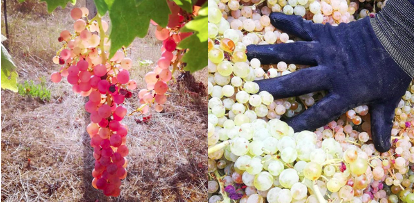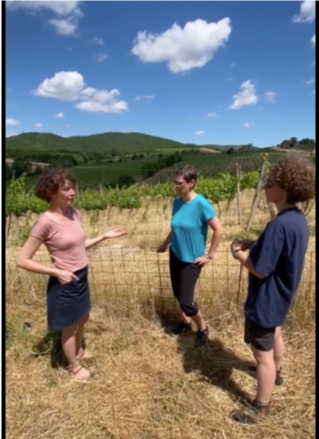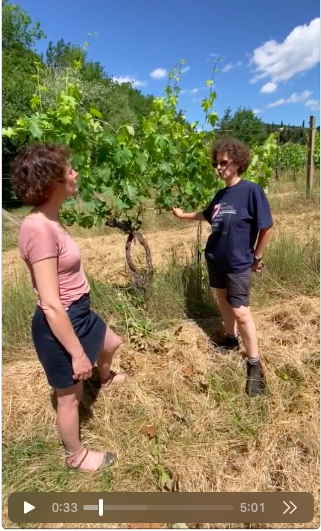Voyage to Tuscay: TUNIA with Francesca & Chiara
Civitella in Val di Chiana
This summer, armed with our video cameras, we traveled to TUNIA, an organic estate located in the east of Tuscany, in the province of Arezzo in the municipality of Val di Chiana. It is the second largest valley in Italy after the Po Valley.
It is known all over the world for the local cattle breed: the Chianina! But it is also a region of diverse and varied agricultural production with fruit trees (apple trees with local varieties, apricot trees, peach trees), and cereals.
It is a preserved and authentic Tuscan region, here there is little tourism, the region is mainly an agricultural and wine region.
Since 2008, Chiara Innocenti and Francesca de Benedetto have been producing a range of wines, grappa and olive oil on 25 hectares of vines formerly worked by nuns from Florence who produced their Vin Santo here. The entire vineyard is organically cultivated and the wines are vinified without any inputs.
SUMMARY
In this report you can read more about :
- Focus on Sangiovese in Civitella in Val di Chiana
- The Sangiovese of TUNIA: CHIASSOBUIO
- Video Vineyard visit at TUNIA
- Harvest 2021
Focus on Sangiovese in Civitella in Val di Chiana

Tunia’s vineyards are located at an altitude of 350 meters. The vines are planted on sandy-clay soils with some limestone and rather balanced in mineral elements. The climate is windy, with a constant light breeze and very little humidity. The entire vineyard is Organic Certified.
During the summer, the days are hot and the nights are cool, it is a very sunny region. All these factors make the region perfect for growing Sangiovese, which needs warmth especially during its veraison period to reach a good phenolic maturity.
Sangiovese is a late variety but with an early budding. The region being sensitive to late frosts, the Tunia vineyard is pruned high, in cordon de Royat. The buds are thus preserved from the cold temperatures of the ground (with at least 1°C difference between the ground temperature and the height of the vines).

The vineyard was planted in 1970 and covers 25 hectares in a single block.
Sangiovese is a variety that mutates easily, so there are more than a hundred different types of Sangiovese, all very different from each other.
The old Sangiovese vines of Tunia are not clones but vines from massal selections made directly in the vineyards of the region and adapted to the local microclimate.
This co-planting of different Sangiovese vines follows ancient principles with two important roles:
- the different vines will produce grapes with diverse characteristics that when blended will produce a more complex wine.
- the assurance each year to produce a more or less regular quantity.
The structure of the Sangiovese of Tunia, like all Sangiovese, has a high acidity and a high tannin content. In the case of old vines like Tunia, the wines are also more concentrated, and they need time to round out, soften their tannins, and develop. This is why the estate has chosen a long maturation in the bottle to gain aromatic finesse and reach a perfect balance of all the elements.
The vintages currently available are 2011, 2012 and 2013.
You can find our full interview with Francesca de Benedetto at this link and hear her present her Sangiovese vineyard.
The Sangiovese of TUNIA

CHIASSOBUIO
IGT Toscana Rosso
Grapes : Sangiovese 90% Colorino 5% Canaiolo 5%
Organic Certified
Age of Vines : planted in 1970
Vinification: 50% is vinified in Stainless steel tank, 50% in foudre of Slavonian oak, with a macération of around 20 days, and spontaneous fermentation with indigenous yeasts.
Ageing : 50% in stainless steel and 50% in foudre of 23 hL of Slavonian oak over 3 years, then ageing in bottle.
Tasting Notes: CHIASSOBUIO
2011: classic year, excellent quality harvest at the end of September –
Robe : Ruby red with a slightly brick red outline.
Nose : Morello cherry, graphite, very floral dried red roses and baking spices, leather.
Mouth : the wine is very fruity, the notes of red cherries are mixed with those of sweet tobacco, the tannins are silky and well-developed; the wine presents a beautiful length.
2012: hot year, the harvest was one week early
Robe: ruby red with a brick red exterior
Nose: very herbal with notes of rosemary and thyme, cherry tomatoes, infused tea, cumin, coriander and paprika.
Palate: savory, with hints of iron and graphite, leather and finishes with notes of tomato leaves and a strong presence of rustic tannins. This wine will be an excellent companion to steak!
2013: hotter year than 2012, harvest was around 25 of September.
Robe: deep ruby red center and rim
Nose: is more fruity than 2012 with notes of dried red cherries and roses, sweet tobacco, baking spices but with a mix of fenugreek and cumin.
Palate: notes of juicy red cherries, smoky tar, balsamic notes, cherry tomatoes and a saline finish. Very fine tannins.
Video Visit at TUNIA
During our visit, we took the time to interview Francesca and Chiara on subjects that concern them on a daily basis: viticulture, vinification, but also all the obstacles they encounter during the vegetative cycle of the vine.
Harvest 2021
Francesca’s word to describe the harvest: “Vintage in Reverse!”
To read the full vintage report, please click here!




